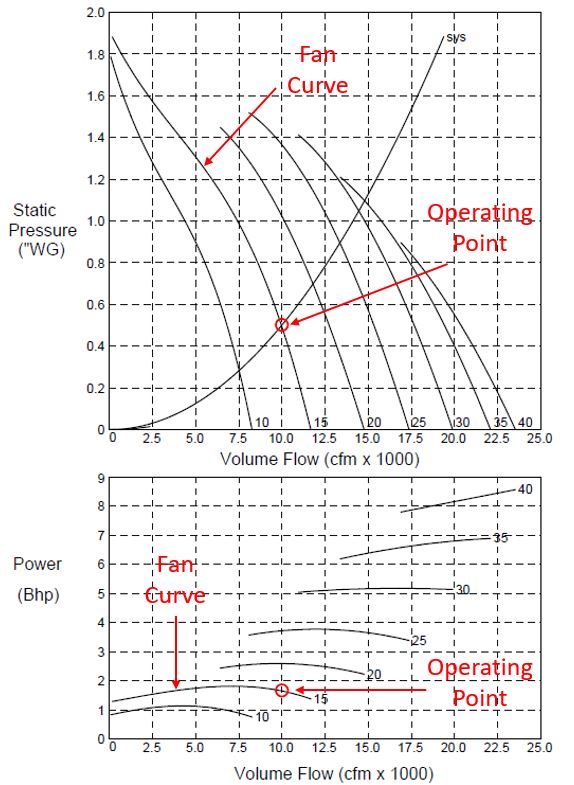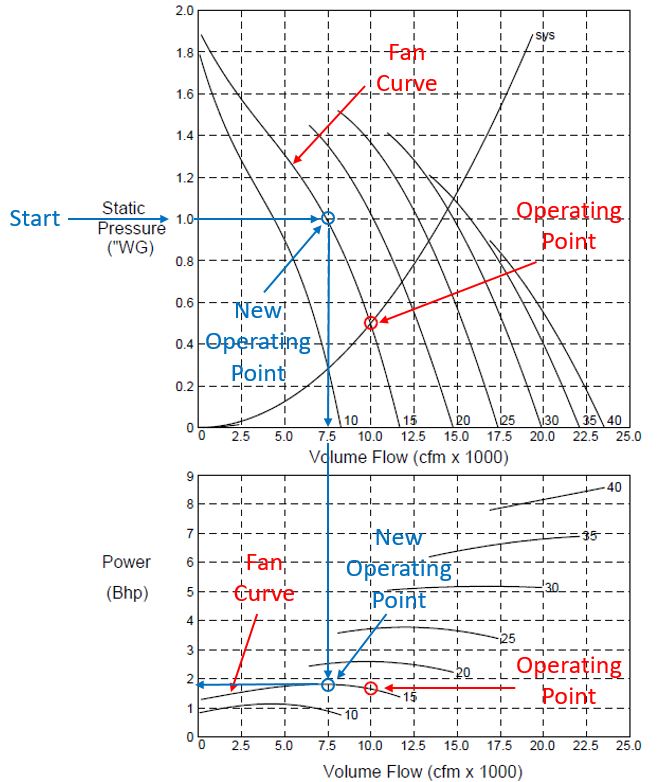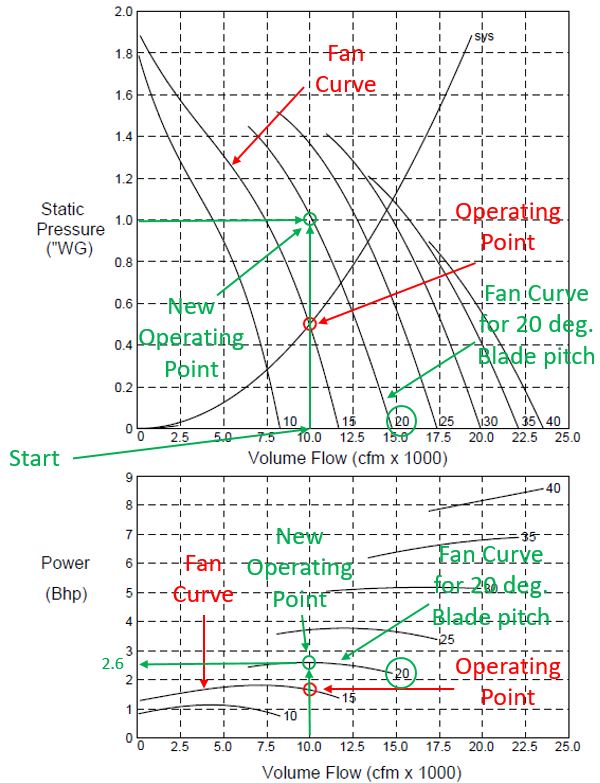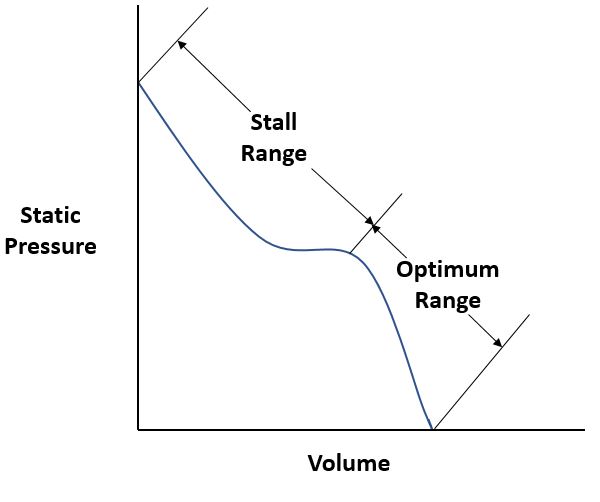The ability to read a fan curve has become a dying skill set. With the introduction of fan selection software, fan selection has become as easy as entering the required inputs and then letting the software interpret which fan is best suited for the operating conditions. But, what will someone do if years after the fan is installed, there are proposed changes to the ventilation system that will change the original operating conditions? That is when it will be valuable to be able to read a fan curve to know how the fan will perform under the new operating conditions.
What is a Fan Curve?
The simple description of a fan curve is that it provides a graphical representation of fan performance. Most fan curves will present the performance of Volume vs. Static Pressure and Volume vs. Brake Horsepower. As the names implies, these relationships are not linear. More about that after we discuss reading a fan curve.
It is important to understand that fan performance represented on a fan curve is unique to a fan as described by three parameters: diameter, speed and blade pitch angle. If any of those three parameters change, the fan performance changes and there will be a different set of curves for the relationships of volume, static pressure and brake horsepower.
Terminology
There are three key terms used on a fan curve. The horizontal axis of a fan curve shows the volume of air produced by the fan. Most US manufacturers will measure fan volume in cubic feet per minute or CFM.
The vertical axis of a fan curve will show static pressure and brake horsepower. As discussed in our article on Fan Pressure Losses, most US manufacturers incorporate the velocity or dynamic pressure losses into their fan curves. That means that static pressure on the fan curve is defined as only the sum of the static pressure losses of the ventilation system components. This is measured in inches water gauge or in. w.g.
Brake horsepower or Bhp is defined as the amount of force required to brake a motor. On a fan curve, it will indicate the amount of horsepower required by the fan to produce a certain volume of air. The required Bhp will determine how the fan motor is sized.
Reading A Fan Curve
Now that we have reviewed what a fan curve is and its terminology, let’s look at reading a fan curve. Our example fan is a 30” supply fan with a 2 hp, 1750 RPM motor and 15 degree blade pitch angle. It was selected to provide 10,000 CFM at 0.5 in. w.g. Below are the Volume vs. Static Pressure and Volume vs. Brake Horsepower fan curves produced by our fan selection software. The red circle on the curve for our example fan shows the selected operating point of the fan in the ventilation system. Note that our software also produces the curves for fans that have the same diameter and speed, but have 10, 20, 25, 30, 35 and 40 degree blade pitch angles. These additional fan curves will be useful later in our example.

Now let’s assume that after operating the supply fan for a period of time, the customer wants to add a filter section. The static pressure loss of the filter section is 0.5 in. w.g. which means the new total static pressure loss of the ventilation system is 1.0 in. w.g.
To see where the new operating point will be, we start by locating 1.0 in. w.g. on the left axis of the Volume vs. Static Pressure curve. Now move straight across until we intersect the curve for our supply fan. This is the new operating point.
To determine the air flow at the new operating point, we move straight down until we intersect the horizontal Volume axis. At 1.0 in. w.g., our supply fan will now only produce 7,500 CFM.
The new operating point on the Volume vs. Brake Horsepower curve is found by continuing to move straight down until we intersect with our fan curve. Moving straight across to the left, we see that the Bhp required to produce 7,500 CFM at 1.0 im. W.g. is less than 2. That means that the customer wouldn’t need to change the motor on the fan if they are satisfied with only 7,500 CFM of air flow.

But what if the customer wants to maintain 10,000 CFM of air flow? How do we determine what needs to be modified on the fan to do that? We go to the Volume vs. Static Pressure curve and find the 10,000 CFM point on the Volume axis. Now we go straight up until we intersect with the 1.0 in. w.g. line. What we see is that our new operating point is on the curve for a fan with a 20 degree blade pitch angle.
To find out how much Bhp is required for a 30”, 1750 RPM and 20 deg blade pitch angle fan, we find 10,000 CFM on the Volume vs. Brake Horsepower curve and move straight up until we intersect with the curve for the 20 degree blade pitch angle fan. From the new operating point, we move straight to the left and find that we intersect the Bhp axis at about 2.6.

Based upon this reading of the fan curves, we can tell the customer that they can maintain 10,000 CFM without totally replacing the fan by changing the propeller blade pitch angle to 20 degrees and replacing the 2 hp motor with a 3 hp motor.
Non-linear Relationship
As mentioned above, the relationships between Volume vs. Static Pressure and Volume vs. Brake Horsepower are not linear. As the static pressure of a ventilation system increases, it has a larger impact on the air flow from a fan. What the curves produced by our selection software don’t show is that some of the fan curves will have a stall range. The stall range is where the same amount of static pressure might have two or more volume points.
The reason our selection software doesn’t show the full fan curve is because it won’t allow a person to make a selection in the stall range. But if our selection software did show the full curves for fans with blade pitch angles 20 through 40, they would look something like this:

The important thing to remember when using a fan curve to make a selection is to identify the stall range and make the selection in the optimum range.
Conclusion
I hope that this example has been useful in both teaching you how to read a fan curve and to appreciate the value of the skill set. Our ventilation experts are well versed at using fan curves to make selections and solve problems. If you need help reading a fan curve or are just curious to learn more about fan curves, contact Eldridge and one of ventilation experts will be happy to assist you.
